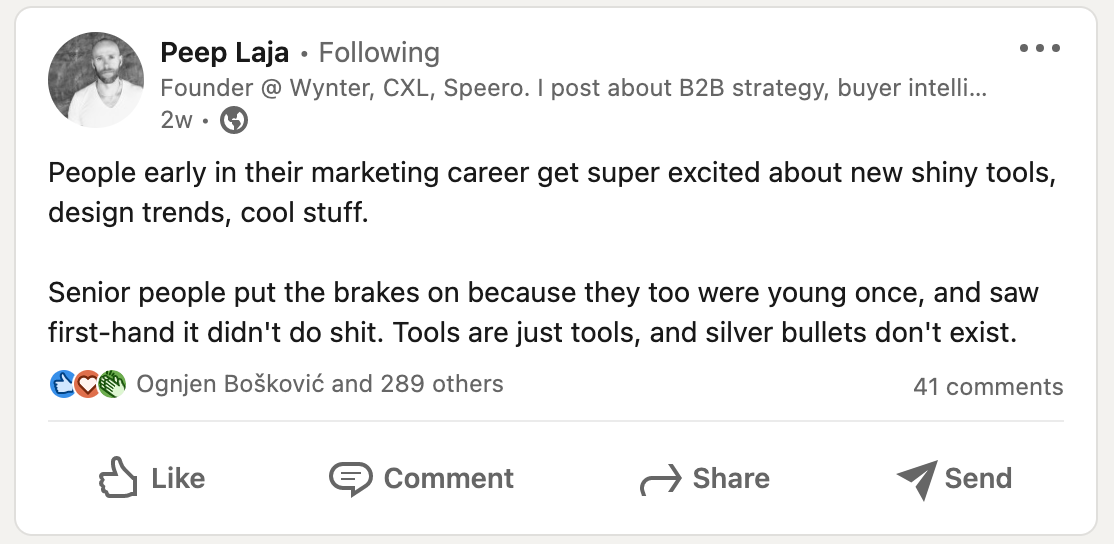Do You Really Need Another Tool?
You've heard it said before.
"Technology isn't a silver bullet."
Peep Laja tweeted something similar recently as well:

But platitudes don't always hold up when someone on your team is making a compelling case for why this new software or tool is necessary to be efficient, hit the goals set for them, and so on.
Here are the 3 areas I explore to better understand if something is truly necessary and gauge the impact or implications of bringing it into the tech stack.
1. Autonomy vs Process
If a tool is standalone (no integrations needed), then it is typically isolated to a specific team or function and aimed at helping someone be faster or more efficient.
Great.
The one gotcha here though is understanding if getting this will impact PROCESS in any way.
Example
If a $79/mo tool is for marketing to be able to create their own ad creative for example, it doesn't require any integrations, but it does impact the process.
Now marketing has autonomy but the design team still needs to have a way to provide style guides, approve assets, and so on.
Your $79/mo tool that was a no-brainer to make your team more efficient is now complicating work for several people and landing you in a bunch of meetings to create new processes. 👎
So even if a tool doesn't need to integrate with anything else, it is important to understand how else it might impact process or other parts of the company.
2. The Need for Integrations
Any tool that requires integration, regardless of how much it costs per year, deserves more scrutiny.
Here's the next set of questions related to integrations:
- Are there native integrations in place for all of the tools we need to connect?
- How confident are we that the data we are integrating is good?
- Do these tools require bi-directional sync, or is everything flowing in one direction?
That's a pretty limited set of questions, but it tells you a lot.
Native Integrations
No native integration means you are paying to build (AND MAINTAIN) custom integrations or you are going to cobble it together with Zapier.
Data Quality
Good tools with bad data are bad tools. Don't believe that adding another tool and integration is going to solve your data issues. Garbage in, garbage out.
Data Flow
Mono-directional data flow isn't too bad. Passing leads through Clearbit for enrichment or sending Google Analytics data to Databox is fairly simple.
Bi-directional syncs for data that is accessed by other tools and needs to be kept up to date for routing logic, reporting, or other critical processes...woof. Not that it can't be done, but it will always being more challenging and significant upkeep to maintain working conditions.
So, you can see that with these three high-level questions, you can pretty quickly understand how complex, reliable, and maintenance-heavy this new tool will be for your team.
3. The Real Problem
At the heart of many new technology requests, is a challenge that can be overcome without a new tool.
Make sure new technology isn't actually compensating for...
- Another person or team not doing their job well
- A lack of training or understanding (i.e. we want to use Data Studio because we aren't comfortable using Looker)
- Not having a real strategy
The list could go on, but you get the point.
Finding the Balance
It is ironic that companies make tech stack decisions faster and with less scrutiny early in their company life, yet the early tech stack is the foundation for how the company grows.
You must find the balance between bringing on tools and platforms that are too big for what you need and tools that you will outgrow every 12 months.
Quick Tip
My recommendation is to sit down once per year and talk about where you see things growing in the next 18 months. This will help you see ahead to where you think you may outgrow current tech or need to add in new tools.
The more you can be ahead of these decisions, the less you will make reactive decisions in the moment that lead to tech debt and future headaches.
Moving Forward
So to recap:
- You want to make sure that standalone tools don't negatively affect process or other teams
- Ask the big questions around integrations needed
- Dig into the heart of the problem that may not require new technology to solve
- Strike a balance with overbuying and underbuying tools for your stage of growth
- Evalute future needs once per year
And remember, technology isn't a silver bullet.
